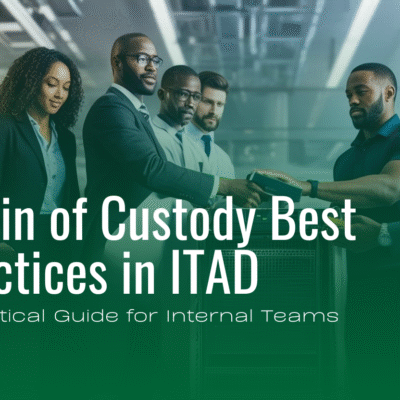Introduction
When businesses retire IT equipment, ensuring data security doesn’t end with device shutdown. It extends to how those assets are physically handled, stored, and ultimately destroyed or repurposed. This is where a strong chain of custody becomes critical.
Chain of custody refers to the documented, auditable path that IT assets follow throughout the disposition process—from decommissioning at the business site to final destruction or resale by a certified ITAD provider. Without strict control and traceability, businesses risk data breaches, compliance violations, and financial penalties.
This guide breaks down why chain of custody matters in ITAD and how businesses can implement best practices to protect sensitive information and meet regulatory standards.
📌 Related: Why Businesses Need a Solid ITAD Strategy to Protect Data
Why Chain of Custody Matters in IT Asset Disposition
Chain of custody is a cornerstone of secure IT asset disposition. It ensures that:
- Assets are accounted for at every step in the ITAD process.
- Data remains protected against unauthorized access or theft.
- Companies maintain compliance with privacy regulations such as HIPAA, GDPR, and ISO 27001.
- Businesses are protected during audits and can prove responsible handling of sensitive data.
A weak or missing chain of custody exposes businesses to security risks, regulatory scrutiny, and reputational damage.
📌 Related: Understanding HIPAA Compliance in ITAD Services
Key Elements of a Secure Chain of Custody
To ensure IT assets are protected, businesses should focus on building a chain of custody that includes:
1. Asset Tagging and Documentation
Each IT asset must be clearly identified and logged before leaving its original location. Documentation should include:
- Serial numbers and asset IDs
- Device types and conditions
- Assigned owners or users
This initial record ensures full visibility throughout the asset’s lifecycle.
2. Secure Packaging and Transport
Moving IT assets between facilities introduces risks. Best practices include:
- Sealing devices in tamper-proof packaging.
- Using locked, GPS-tracked vehicles operated by vetted personnel.
- Assigning transportation responsibility only to certified ITAD vendors like e-Stewards certified recyclers.
3. Real-Time Tracking
Where possible, IT assets should be tracked in real time during transportation and storage. GPS tracking combined with barcode or RFID scanning helps maintain continuous visibility.
4. Chain of Custody Documentation and Signatures
Every handoff must be documented with:
- Signatures from both releasing and receiving parties.
- Date and time stamps.
- Updated location details.
This creates an auditable trail to confirm that assets were securely handled.
5. Final Disposition and Certification
Once assets are wiped, destroyed, or resold, businesses should receive:
- Certificates of Data Destruction
- Recycling or resale reports
- Final inventory lists documenting asset status
These documents are crucial for compliance audits and risk management.
📌 Related: How to Choose an ITAD Vendor You Can Trust
Best Practices for Managing ITAD Chain of Custody
Following a few key best practices will help businesses strengthen their chain of custody procedures:
- Vet ITAD vendors carefully: Choose companies certified by e-Stewards, R2, or ISO standards for secure processing.
- Use asset tracking software: Tools that integrate with GPS and barcode systems make auditing simple and accurate.
- Train internal teams: Staff should understand chain of custody requirements and know how to handle decommissioned assets securely.
- Conduct regular audits: Periodic checks ensure that processes are followed consistently and allow early identification of any weak points.
- Plan for remote or multi-location environments: Ensure decentralized offices follow the same chain of custody procedures to maintain uniformity across regions.
📌 Related: Managing ITAD Across Multiple Locations — coming soon!
Conclusion: Chain of Custody Protects Your Business and Your Data
A strong chain of custody protects your business’s most valuable asset—its data. Without it, even well-intentioned IT asset disposal efforts can lead to compliance failures, security breaches, and lost trust.
By implementing a secure, auditable chain of custody process and partnering with certified ITAD providers, businesses can ensure safe, compliant, and environmentally responsible IT asset disposition. At IER ITAD Electronics Recycling, we specialize in secure, fully documented chain of custody services to help businesses stay protected and compliant. Contact us today to learn how we can strengthen your ITAD program.





